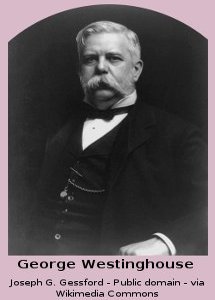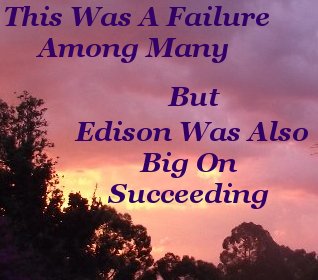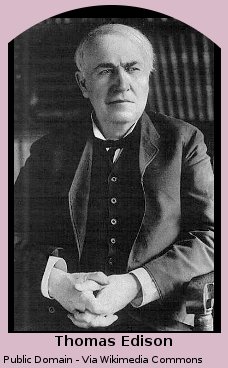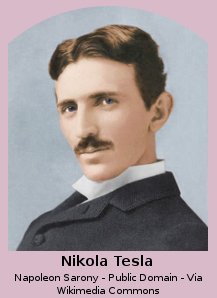Human Intelligence Determines Humanities Technological Direction
Part 19 - Part 18
Thomas Edison
Human intelligence is involved in an intellectual tug of war. The winner of this struggle will determine Humanities future Technological Direction. Sound familiar?
Thomas Alva Edison, (1847-1931) who spent a number of his earlier years as one of the most capable Telegraph
Operators around, was a commanding player in the US industrialization
and domestic supply, of Direct Current Electricity. Edison placed total
faith in his belief that DC was the Future.
Others Thought differently.
At that period - late nineteenth century
- Direct Current was deemed to be safe. It was easy to handle and work
with. It could be stored in a battery as a backup supply, and readily
employed in electroplating.
These
practical benefits were simply not to be had with DC's rival, AC -
Alternating Current. Edison considered the higher operating Voltages of
Alternating Current as dangerous. Many folk still do today.
Thomas
Edison maintained he was concerned with public safety. His systems did
not present any serious hazards to endanger the Public.
Good Reason For Opposition
While controversy remains over his opposition to Alternating Current, according to his biography, authored by Frank Lewis Dyer and Thomas Commerford Martin, Edison was not totally opposed to AC.
Edison
recognized the unique advantages AC offered when transmitting over long
distances. He readily acknowledging that it should be used for long
distant transmission. Then, once it arrived at its destination, the
Alternating Current used to operate Direct Current generators, and DC
used for consumer supply.
Edison's Intention was to supply
harmless, efficient, and economical energy for lighting in densely
populated areas, competing with Lighting powered by Coal Gas.
There
was nothing intrinsically defective with Thomas Edison's Electricity
supply system. He had designed and built an admirably efficient and
complete Instrumentality for lighting, worthy of the highest praise.
The
prevailing technical drawbacks of Direct Current though, including
those of distribution, the difficulty of Voltage transformation, and the
application to Industrial Motors, were being increasingly severely
tested. Alternating Current was seen as a magic bullet solution.
As appears to be a Human tradition, the best Minds of this crucial period in Human History could not Cooperate in the interests of the Common Good. Personal opinion held sway, at the expense of clear Thinking.
Nikola Tesla
Electromechanical Engineer, Nikola Tesla, a Serbian born American, (1856-1943), was a latter day Leonardo Da Vinci.
A latter day da Vinci with a well equipped workshop.
Nikola Tesla possessed a First Order Intuitive Mind - Edison was likewise endowed. Tesla was for a short time, employed by Edison. However, unfortunately for Humanity, and our Planet, their difference of opinion regarding whether AC or DC Current was the superior, drove them apart.
During the second half of the 1880's Nikola was awarded a number of separate Patents for a System of Electrical Power Transmission, based on poly-phase - more than one phase - Circuitry.
Tesla's Circuitry was so original, and revolutionary, that his Patent applications went unchallenged. This is a product of the Intuitive aspect of our Human intelligence in action. An aspect of our Human Mind that has this author's undivided attention.
Notwithstanding relative infrequency of Intuitive Thinking, Tesla has not endured alone in exhibiting this fascinating approach to Problem Solving.
These new Patents complimented one he had been awarded earlier in the
decade for a brush-less AC Induction Motor. Tesla's brush-less Induction Motor would soon become a ubiquitous workhorse.
Before that happened though, Nikola's bold ingenuity would be employed as the main assault weapon in a Battle Of Minds between two men that would change the World for ever. One of those men was Thomas Alva Edison.
The other commanding player in the high stakes encounter that was about to eventuate, was George Westinghouse. George had intentions of dominating the Energy market. He also had a plan of action of just how to do that.
Looming Battle
Following a visionary course of action, Westinghouse, (below) persuaded Nikola Tesla to transfer his Patents to Westinghouse's Company, and work for Westinghouse as a consultant.
Westinghouse was all but ready to launch his assault on Thomas Edison and Direct Current.
All
that George Westinghouse required now, was a Transformer to control AC
Voltage. For this too, he purchased an existing Patent. As you might
expect, Nikola Tesla applied his mind to the improvement of the design
of this device.
Armed
with these Patents and Nikola Tesla in his employ, Westinghouse began
his campaign against Edison. For a winner take all approach to the
supply of Electricity. AC versus DC.
The conqueror in this war for domination of Electricity supply, would reform the foundations of Industry, and render
the reigning Industrial Steam Engine, obsolete. Worldwide.
Human Intelligence Sees The Future
American born George Westinghouse, (1846-1914) was possessed of an utterly brilliant Mind. George was a clear Thinking Engineer, Inventor, and Industrialist, who had a direction changing, World-wide impact on the way Railroads operated.

Westinghouse accomplished this unquestionable influence with his
invention of a compressed air Braking System that permitted one man to
execute the braking of a complete train. Paradoxically allowing the
train to travel faster. With increased safely.
Prior to George's
far reaching innovation,Train Braking was effected by applying the
brakes on individual carriages. By operators, in each carriage, manually
applying the brakes, following the directions of the train driver.
Stopping
a massive train in such a primitive manner, would be quite a feat of
coordination under any circumstances. Let alone an emergency situation.
Westinghouse didn't stop there.
Increased
speeds demanded the coordination of the then, too, manual Signaling
System. A crude system fraught with Human error caused by
misinterpretation.
George Westinghouse, using his ever agile
mind, addressed this shortcoming with his usual efficient, effective
manner. To this end he invented and implemented an Electro-Pneumatic,
almost foolproof, system of signals, to direct train coordination and
timetables.
This was the mind Thomas Edison was up against
Ten Year Battle
After a ten year strategic engagement with Westinghouse, Thomas Edison lost out to a more practical - for the time - system. The consequences of this thoroughly arrant encounter we are now living with, invite pause for reflection.
At this point, a question begs to be asked - How would the World look today, had these three brilliant minds purposely implemented the Law of Cooperation. And, even better, the Law of Collaboration, and worked together in total Harmony. Amalgamating their extensive Thinking ability to extract the maximum benefits inherent in both forms of Energy. For the prosperity of Humanity.
We are facing an equally poignant situation today, how will we allow Artificial Intelligence to develop????

Perhaps today we would all be driving Electric Cars, and drawing Solar Energy drawn from super efficient storage facilities.
How desirable would that be for our suffering environment? And our personal and collective bank balances.
Apparently, Rational Thinking, or even simple Logic, did not enter the Conscious awareness of these otherwise great problem solvers. Bloody mindedness and an unjustifiable desire to "win" over an opponent, at whatever it may cost, dominated proceedings.
This same retrogressive shortcoming in our collective Thinking skills still exists today. If not addressed and resolved, Humanity is merely hanging a millstone around our collective necks. That is about as plainly simple as this author can describe such destructive behavior.
No small business
The power stations and related infrastructure Edison had established
was no small business. His Electricity Supply System was the standard
for the United States. With interests in other Countries.
Edison's Company, Edison Electric, was the antecedent of one of the largest companies in the World, General Electric.
Direct
Current losing it's preeminence was one failure among many. However,
Thomas Edison was also big on succeeding. He understood just how Human
intelligence functions.
Perhaps his best inspiration was to form an Industrial Park . . .
Thomas
Edison's Menlo Industrial Park endeavor, the first Research and
Development Center, could also claim the title for the first Industrial
Mastermind. It is our loss that the Mastermind Principle was not applied to the supply of Electricity.
A Mastermind has collaboration as it's foundation.
Menlo Industrial Park - in just one six year torrent of astonishing Creativity - according to the Edison Memorial Tower Corporation, delivered around four hundred Inventions.
An outstanding application of Human intelligence
Human Intelligence Rocks!
Part 19 - Part 18
Next - No Boundaries







